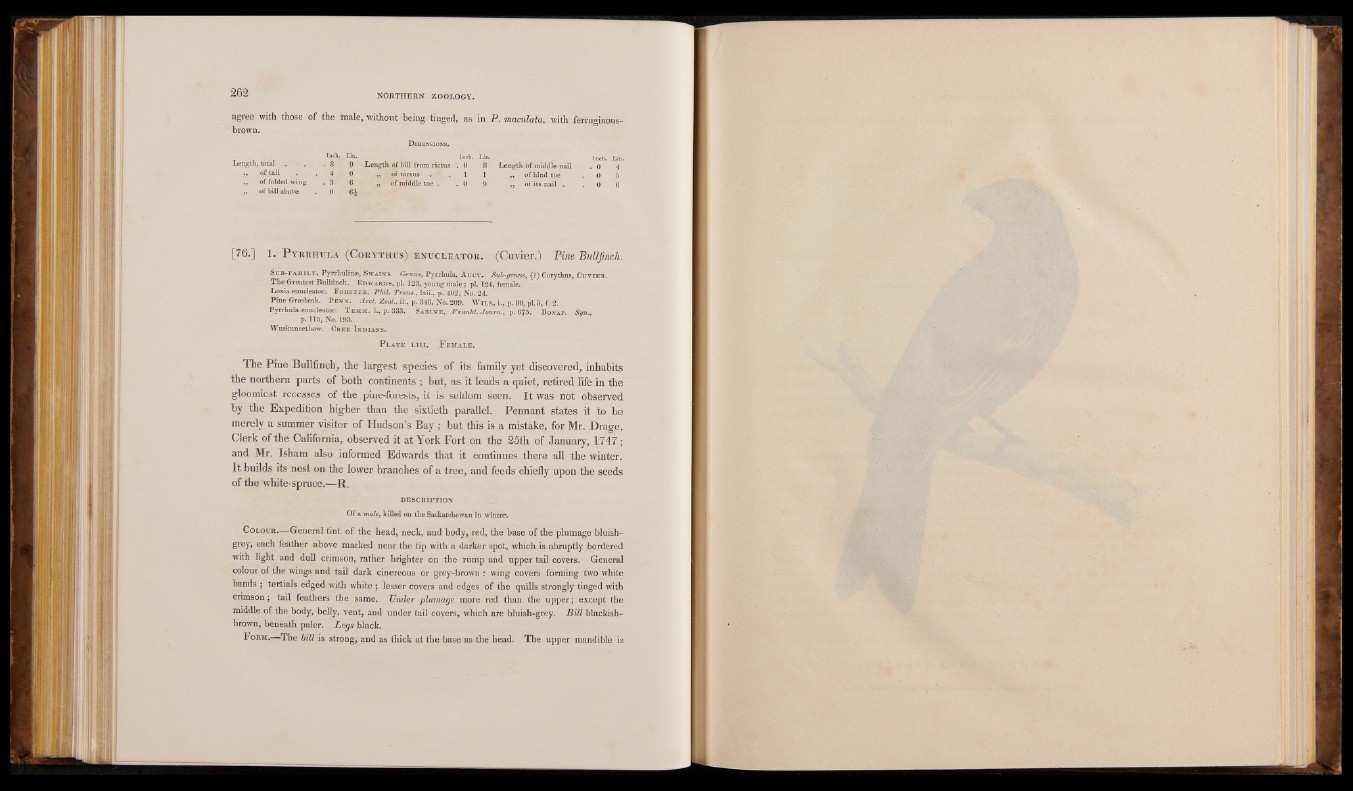
agree with those of the
brown.
male, without being tinged, as in P. maculata, with ferruginous-
Dimensions.
Length, total . • . . 8
tin,
9
„ of tail 4 0
„ of folded wing . 3 6
- ,, of bill above 0
Length of bill from rictus I.n c0h. L8in.
,, of tarsus . . 1 1
-'/»•' of middle toe . . 0 9
Length of middle nail . 0 4
„ of hind toe . 0 5
„ of its nail . . 0 6
[76 .] 1. P y r r h u l a (C o r y t h u s ) e n u c l e a t o r . -(C uvier.) Pine Bullfinch.
Su b -fa s iitY , Pvrrhulinae, Sw ains. Genus, Pyrrhula, Auct. Sub-genus, (?) Corythus, Cu v ie r .
The Greatest Bullfinch. E dwards, pi. 123, young male j pi. 124, female.
Loxia enucleator. F orster, Phil. Trans., lxii., p. 402, No. 24.
Pine Grosbeak, P e n n . Arct. Zool., ii., p. 348, No. 209. W il s ., i., p. 80, pi. 5, f. 2.
Pyrrhula enucleator. T em m . i., p. 333. Sa b in e , Frankl. Joum., p. 675. B onap., -Syn.,
p. 115, No. 193.
Wuskuneethow. Cr e e I n d ia n s .
P late l i ii. F emale.
The Pine Bullfinch, the largest species of its family yet discovered, inhabits
the northern parts of both continents ; but, as it leads a quiet, retired life in the
gloomiest recesses of the pine-forests, it is seldom seen. It was not observed
by the Expedition higher than the sixtieth parallel. Pennant states it to be
merely a summer visitor of Hudson’s Bay ; but this is a mistake, for Mr. Drage,
Clerk of the California, observed it at York Fort on the 25th of January, 1747;
and Mr. Isham also informed Edwards that it continues, there all the winter.
It builds its nest on the lower branches of a tree, and feeds chiefly upon the seeds of the white-spruce.—R.
DESCRIPTION
Of a male, killed on the Saskatchewan in winter.
C olour.— General tint of the head, neck, and body, red, the base of the plumage bluish-
grey, each feather above marked near the tip with a darker spot, which is abruptly bordered
with light and dull crimson, rather brighter on the rump and upper tail covers. General
colour of the wings and tail dark cinereous or grey-brown : wing covers forming two white
bands ; tertials edged with white ; lesser covers and edges of the quills strongly tinged with
crimson; tail feathers the same. Under plumage more red than the upper; except the
middle of the body, belly, vent, and under tail covers, which are bluish-grey. Bill blackish-
brown, beneath paler. Legs black.
F orm.—The bill is strong, and as thick at the base as the head. The upper mandible is